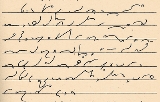
Thomas Natural Shorthand
Encyclopedia
Thomas Natural Shorthand is an English shorthand
system created by Charles A. Thomas which was first published in 1935. Thomas described his system as "designed to meet the existing need for a simple, legible shorthand that is based on already familiar writing lines, and that is written with a minimum number of rules." The system has fallen into disuse with the decline of pen shorthand in the later 20th century, but the spirit of the system lives on in Teeline shorthand
, with which it shares a number of characteristics (although the symbols used in each system are quite different).
 Like Gregg shorthand
Like Gregg shorthand
, and unlike the older Pitman shorthand
, Thomas Natural Shorthand is a "light-line system", i.e. a system which does not employ shading (light and heavy strokes) to distinguish symbols. Unlike earlier light-line systems such as Pernin phonography, cursive rather than angular strokes are employed. However, Thomas Natural differs from Gregg and resembles Pitman in its use of positional writing--vowels are deduced according to whether a form is written on, above, or below the line of writing.
The system aims to be simpler to learn than competing symbol shorthand systems of the time, boasting "only twelve word signs and one abbreviating principle". Total mastery of the system could therefore be achieved much quicker than the major court-reporting systems, and although this simplicity did come with a loss of speed, the speeds achieved were still adequate for secretarial use.
The system's failure to achieve popularity came from its "jack-of-all-trades, master-of-none" position. Those looking for an easy to learn system were far more likely to choose alphabetic systems such as Forkner shorthand
or Speedwriting
; those interested in developing serious shorthand speed were drawn to more established systems with a court reporting track record such as Gregg or Pitman. To the untrained eye, Thomas Natural shorthand bears a close resemblance to Gregg shorthand (despite being unrelated); it was necessary to actually undertake a study of the system to learn how much simpler it really was than Gregg.
Shorthand
Shorthand is an abbreviated symbolic writing method that increases speed or brevity of writing as compared to a normal method of writing a language. The process of writing in shorthand is called stenography, from the Greek stenos and graphē or graphie...
system created by Charles A. Thomas which was first published in 1935. Thomas described his system as "designed to meet the existing need for a simple, legible shorthand that is based on already familiar writing lines, and that is written with a minimum number of rules." The system has fallen into disuse with the decline of pen shorthand in the later 20th century, but the spirit of the system lives on in Teeline shorthand
Teeline Shorthand
Teeline is a shorthand system accepted by the National Council for the Training of Journalists, an organisation for training journalists in the United Kingdom. It was developed in 1968 by James Hill, a teacher of Pitman Shorthand...
, with which it shares a number of characteristics (although the symbols used in each system are quite different).
Characteristics

Gregg Shorthand
Gregg shorthand is a form of stenography that was invented by John Robert Gregg in 1888. Like cursive longhand, it is completely based on elliptical figures and lines that bisect them. Gregg shorthand is the most popular form of pen stenography in the United States and its Spanish adaptation is...
, and unlike the older Pitman shorthand
Pitman Shorthand
Pitman shorthand is a system of shorthand for the English language developed by Englishman Sir Isaac Pitman , who first presented it in 1837. Like most systems of shorthand, it is a phonetic system; the symbols do not represent letters, but rather sounds, and words are, for the most part, written...
, Thomas Natural Shorthand is a "light-line system", i.e. a system which does not employ shading (light and heavy strokes) to distinguish symbols. Unlike earlier light-line systems such as Pernin phonography, cursive rather than angular strokes are employed. However, Thomas Natural differs from Gregg and resembles Pitman in its use of positional writing--vowels are deduced according to whether a form is written on, above, or below the line of writing.
The system aims to be simpler to learn than competing symbol shorthand systems of the time, boasting "only twelve word signs and one abbreviating principle". Total mastery of the system could therefore be achieved much quicker than the major court-reporting systems, and although this simplicity did come with a loss of speed, the speeds achieved were still adequate for secretarial use.
The system's failure to achieve popularity came from its "jack-of-all-trades, master-of-none" position. Those looking for an easy to learn system were far more likely to choose alphabetic systems such as Forkner shorthand
Forkner shorthand
Forkner Shorthand is an alphabetic shorthand created by Hamden L. Forkner and first published in 1952. Its popularity grew to its apex in the 60s through the 80s as those who needed shorthand every day began to favor the lower learning curve of alphabetic systems to the more difficult ...
or Speedwriting
Speedwriting
Speedwriting is a shorthand writing system developed in 1924 by Emma Dearborn, an instructor at the University of Chicago. It uses alphabetic characters and was originally designed so that it could be written by pen, or on a typewriter....
; those interested in developing serious shorthand speed were drawn to more established systems with a court reporting track record such as Gregg or Pitman. To the untrained eye, Thomas Natural shorthand bears a close resemblance to Gregg shorthand (despite being unrelated); it was necessary to actually undertake a study of the system to learn how much simpler it really was than Gregg.

